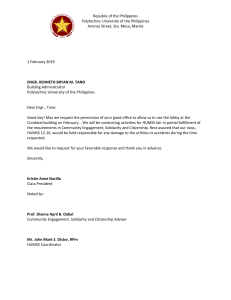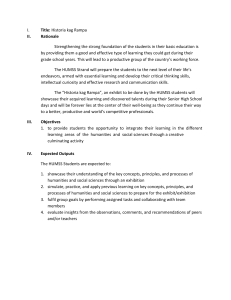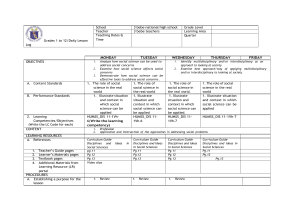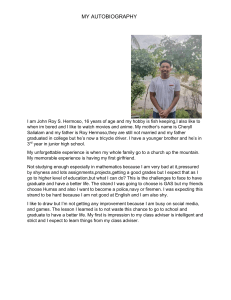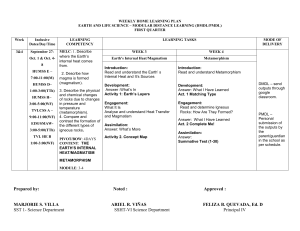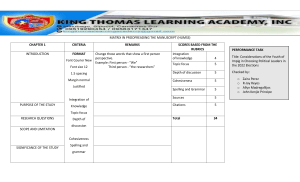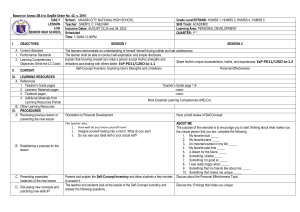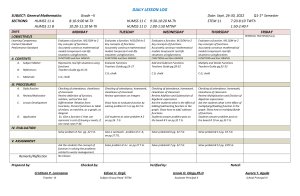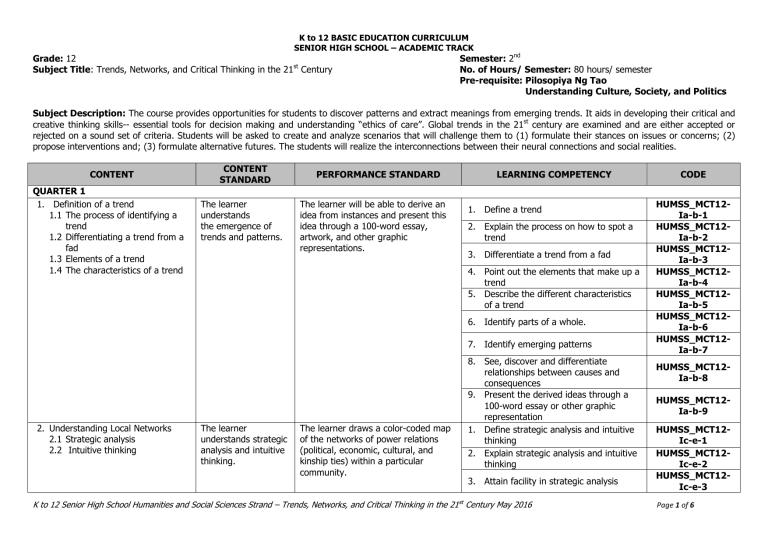
K to 12 BASIC EDUCATION CURRICULUM SENIOR HIGH SCHOOL – ACADEMIC TRACK Grade: 12 Subject Title: Trends, Networks, and Critical Thinking in the 21st Century Semester: 2nd No. of Hours/ Semester: 80 hours/ semester Pre-requisite: Pilosopiya Ng Tao Understanding Culture, Society, and Politics Subject Description: The course provides opportunities for students to discover patterns and extract meanings from emerging trends. It aids in developing their critical and creative thinking skills-- essential tools for decision making and understanding “ethics of care”. Global trends in the 21st century are examined and are either accepted or rejected on a sound set of criteria. Students will be asked to create and analyze scenarios that will challenge them to (1) formulate their stances on issues or concerns; (2) propose interventions and; (3) formulate alternative futures. The students will realize the interconnections between their neural connections and social realities. CONTENT QUARTER 1 1. Definition of a trend 1.1 The process of identifying a trend 1.2 Differentiating a trend from a fad 1.3 Elements of a trend 1.4 The characteristics of a trend CONTENT STANDARD The learner understands the emergence of trends and patterns. PERFORMANCE STANDARD The learner will be able to derive an idea from instances and present this idea through a 100-word essay, artwork, and other graphic representations. LEARNING COMPETENCY 1. Define a trend 2. Explain the process on how to spot a trend 3. Differentiate a trend from a fad 4. Point out the elements that make up a trend 5. Describe the different characteristics of a trend 6. Identify parts of a whole. 7. Identify emerging patterns 2. Understanding Local Networks 2.1 Strategic analysis 2.2 Intuitive thinking The learner understands strategic analysis and intuitive thinking. The learner draws a color-coded map of the networks of power relations (political, economic, cultural, and kinship ties) within a particular community. 8. See, discover and differentiate relationships between causes and consequences 9. Present the derived ideas through a 100-word essay or other graphic representation 1. Define strategic analysis and intuitive thinking 2. Explain strategic analysis and intuitive thinking 3. Attain facility in strategic analysis K to 12 Senior High School Humanities and Social Sciences Strand – Trends, Networks, and Critical Thinking in the 21st Century May 2016 CODE HUMSS_MCT12Ia-b-1 HUMSS_MCT12Ia-b-2 HUMSS_MCT12Ia-b-3 HUMSS_MCT12Ia-b-4 HUMSS_MCT12Ia-b-5 HUMSS_MCT12Ia-b-6 HUMSS_MCT12Ia-b-7 HUMSS_MCT12Ia-b-8 HUMSS_MCT12Ia-b-9 HUMSS_MCT12Ic-e-1 HUMSS_MCT12Ic-e-2 HUMSS_MCT12Ic-e-3 Page 1 of 6 K to 12 BASIC EDUCATION CURRICULUM SENIOR HIGH SCHOOL – ACADEMIC TRACK CONTENT 3. Global Networks 3.1 Labor 3.2 Migration CONTENT STANDARD The learner understands the components, operations, effects, and networks of globalization in his/her daily life. PERFORMANCE STANDARD The learner locates on a map the different geographical origins of the various components/elements of an industrial/technological/agricultural product and writes a reflection essay on the insights gathered from the exercise. The learner locates on a map the workplaces of the OFWs in their community and writes a reflection paper on the effects of labor migration to their community. 4. Planetary Networks: Climate Change 4.1 The effects of consumption and production patterns to climate change The learner understands the consequences of personal and local action to global and The learner 1) analyzes how production and consumption habits contribute to the problem of climate change and explain LEARNING COMPETENCY CODE 4. Use intuitive thinking in dealing with varied activities 5. Differentiate key components in strategic analysis and intuitive thinking 6. Examine how the map of social networks can be used to introduce creative solutions to a particular problem in a community using intuitive thinking 1. Give examples of various activities in one’s daily life that show the concrete effects of globalization 2. Explain the comprehensive effects of globalization 3. Show the interconnectedness of peoples and nations 4. Explain and demonstrate the benefits of collaboration and cooperation 5. Identify and discuss the different contributions of the parts to a whole 6. Stress the important role of the creative imagination in putting together the various parts of a whole 7. Create a map to show the origins of the different component s of a gadget, business enterprise, industrial/technological/agricultural product, etc. 8. Write a reflection essay on the insights generated from the map. 1. List activities that exemplify care for the environment 2. Explain the effects of consumption and production patterns that contribute to the problem of climate change HUMSS_MCT12Ic-e-4 HUMSS_MCT12Ic-e-5 K to 12 Senior High School Humanities and Social Sciences Strand – Trends, Networks, and Critical Thinking in the 21st Century May 2016 HUMSS_MCT12Ic-e-6 HUMSS_MCT12If-g-1 HUMSS_MCT12If-g-2 HUMSS_MCT12If-g-3 HUMSS_MCT12If-g-4 HUMSS_MCT12If-g-5 HUMSS_MCT12If-g-6 HUMSS_MCT12If-g-7 HUMSS_MCT12If-g-8 HUMSS_MCT12Ih-i-1 HUMSS_MCT12Ih-i-2 Page 2 of 6 K to 12 BASIC EDUCATION CURRICULUM SENIOR HIGH SCHOOL – ACADEMIC TRACK CONTENT 4.2 The effects of climate change 4.3 Steps to address the problems of climate change CONTENT STANDARD planetary climate change. PERFORMANCE STANDARD why. 2) writes a resolution that you can share with your friends about how you can personally contribute towards solving the problem of climate change. LEARNING COMPETENCY CODE 3. Explain and illustrate personal contributions that can actually solve the problem of climate change HUMSS_MCT12Ih-i-3 4. Make a stand on how the consequences of one’s action affect the lives of others and the environment HUMSS_MCT12Ih-i-4 Culminating Activity or Exam – 1 week Discuss demonstrate and examine the relationship between network and trends and how it affects you. QUARTER 2 1. Identify preferred democratic practices 5. Democratic Interventions The learner understands the meaning and dimensions of democracy. 6. Information Communication Technology (ICT) The learner understands how ICT enslaves, emancipates, and empowers individuals. using any form of oral presentation The learner explains creatively the ill effects of undemocratic practices related to factors such as gender biases, poverty, political marginalization, racial inequality, cultural domination, crisis of representation and politics of recognition. The learner organizes and mobilizes an event that deals with a significant global issue, using ICT. 2. Explain and analyze the reason for their preferences 3. Illustrate the benefits of democratic participation 4. Explain the importance of participation in democracy 5. Distinguish/differentiate participatory from representative democracy 6. Generate the criteria to assess prevailing political and social institutions 7. Conceptualize /formulate what can be a viable alternative to undemocratic practices. 1. Identify dimensions of technology that are enabling and not inhibiting 2. Discuss the benefits of technology 3. Utilize technology effectively rather than be enslaved by it K to 12 Senior High School Humanities and Social Sciences Strand – Trends, Networks, and Critical Thinking in the 21st Century May 2016 HUMSS_MCT12IIa-c-1 HUMSS_MCT12IIa-c-2 HUMSS_MCT12IIa-c-3 HUMSS_MCT12IIa-c-4 HUMSS_MCT12IIa-c-5 HUMSS_MCT12IIa-c-6 HUMSS_MCT12IIa-c-7 HUMSS_MCT12IId-f-1 HUMSS_MCT12IId-f-2 HUMSS_MCT12IId-f-3 Page 3 of 6 K to 12 BASIC EDUCATION CURRICULUM SENIOR HIGH SCHOOL – ACADEMIC TRACK CONTENT 7. Neural and Social Networks 7.1 Connections, Relationships, and Networks 7.2 The Neural and Social Networks CONTENT STANDARD The learner understands the parallelism between neural and social networks. PERFORMANCE STANDARD The learner creates a social map that traces the various roles that students play in the community (family members, community leader, etc.) and rank the significance of the roles played within the community. LEARNING COMPETENCY CODE 4. Identify the weakest link in a system using strategic and intuitive thinking 5. Explain how information communication technology can facilitate social relationships and political movements (occupy movements) 6. Make or propose a creative intervention to improve human life HUMSS_MCT12IId-f-4 1. Identify connections, relationship, and networks HUMSS_MCT12IIg-i-1 2. Illustrate how the brain or neural network works HUMSS_MCT12IIg-i-2 3. Compare the neural networks with social networks 4. Establish linkage between self and the social network one belongs to 5. Demonstrate how thinking processes are shaped by social relationships 6. Identify the significant social roles students play within the community by creating a social map of their relationships 7. Rank the roles in the community in terms of significance and explain why HUMSS_MCT12IIg-i-3 HUMSS_MCT12IIg-i-4 HUMSS_MCT12IIg-i-5 HUMSS_MCT12IId-f-5 HUMSS_MCT12IId-f-6 HUMSS_MCT12IIg-i-6 HUMSS_MCT12IIg-i-7 Culminating Activity or Exam – 1 week On the basis of the different outputs per quarter, propose the kind of future you want, explain why you want that future, and illustrate how will you get there. K to 12 Senior High School Humanities and Social Sciences Strand – Trends, Networks, and Critical Thinking in the 21st Century May 2016 Page 4 of 6 K to 12 BASIC EDUCATION CURRICULUM SENIOR HIGH SCHOOL – ACADEMIC TRACK CODE BOOK LEGEND SAMPLE CODE: HUMSS_MCT12-Ia-b-2 LEGEND SAMPLE Track/ Strand Humanities and Social Sciences Strand HUMSS underscore_ First Entry Track/Strand Subject Trends, Networks and Critical Thinking in the 21st Century MCT Grade Level 12 12 - Roman Numeral *Zero if no specific quarter Quarter 1 I Lowercase Letter *Put a hyphen (-) in between letters to indicate more than a specific week Week 2 weeks a-b - Arabic Number Competency Explain the process on how to spot a trend. K to 12 Senior High School Humanities and Social Sciences Strand – Trends, Networks, and Critical Thinking in the 21st Century May 2016 2 Page 5 of 6 K to 12 BASIC EDUCATION CURRICULUM SENIOR HIGH SCHOOL – ACADEMIC TRACK References: Bremmer, Ian. "How to Lead in Ambiguous Times." Strategy and Business. February 2015, 2. Accessed May 6, 2016. http://www.strategybusiness.com/article/00306. Burkitt, Frank. "A Strategist’s Guide to the Internet of Things." Strategy and Business. November 2014, 10. Accessed May 6, 2016. http://www.strategybusiness.com/article/00294. Lancefield, David R. V. When_Megatrends_Collide.pdf. May 6, 2015. http://www.strategybusiness.com/media/file/00309 K to 12 Senior High School Humanities and Social Sciences Strand – Trends, Networks, and Critical Thinking in the 21st Century May 2016 Page 6 of 6
